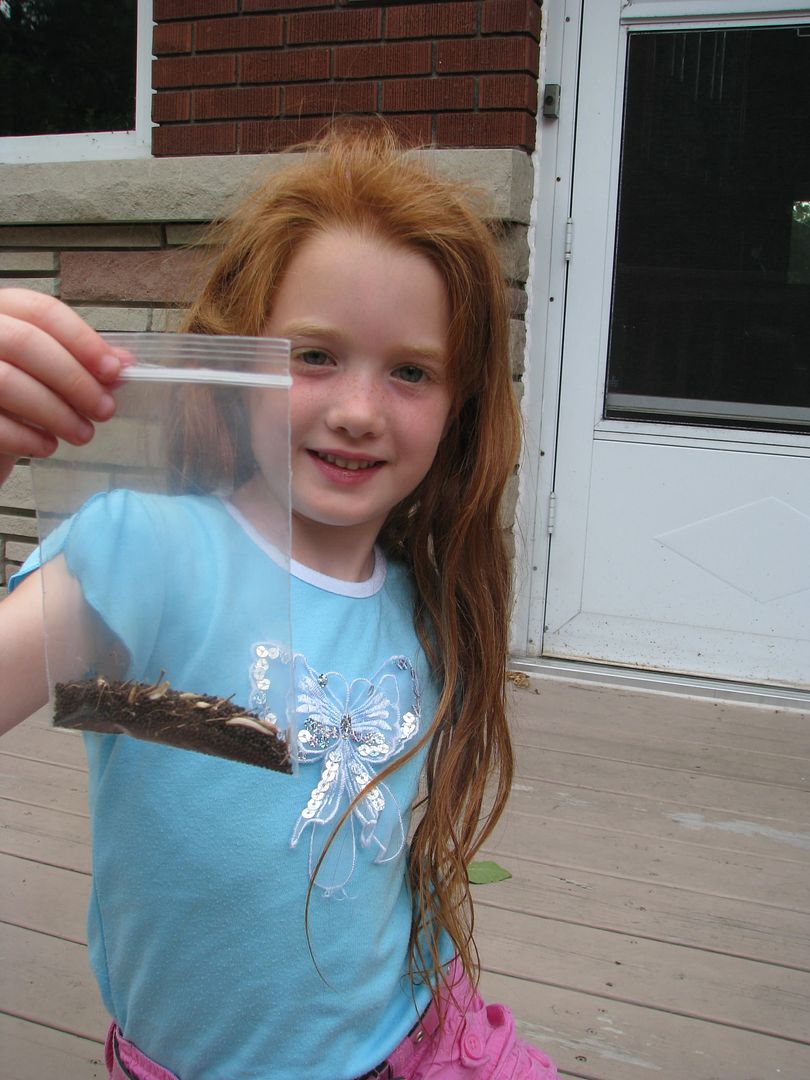
Eldest holding a freshly saved bag of Red Rock Mammoth cabbage seed.
Life Cycle
To save seeds from annual brassicas, like mustards or many broccolis, grow the plant as you normally would but don't yank it out of the garden when it starts to turn buttery yellow with blooms. You may be surprised to see a five foot stalk emerge from your three inch high mustard plant so be prepared with stakes or cages. Or if you are the sort of gardener that I am -

Red Osaka mustard in flower
Biennials such as cabbage and kale will need to go through vernalization before they will go to seed. That's a fancy word meaning: experience a period of cold. You can trick a plant into thinking its gone through a two year cycle by starting it indoors and then putting it outside while the weather is still cool - a technique used to get globe artichokes to produce in one year. I've never bothered trying this with brassicas.
Some people will have no issues overwintering these plants in the ground so will simply be nodding their heads at this point. Others will be sighing about having to coddle them in cellar during the frigid months. Don't despair. If storing cabbages with their roots planted in moist sand for months sounds like too much work, there are alternatives. The easiest is the wait and see method. That which makes it through the winter is considered a winner! To give them more of a chance, especially if you live in an area that has limited, inconsistent snow cover and very low temperatures, provide some insulation yourself by mulching with loosely packed leaves, pine broughs, rose cones etc... after cold has set in and mice have found other living arrangements. Don't worry if the tender bits like heads rot off, the stem may still be alive sending out leaves and flowers. Some people experiment with overwintering cabbages at different stages of growth to see what survives the best.
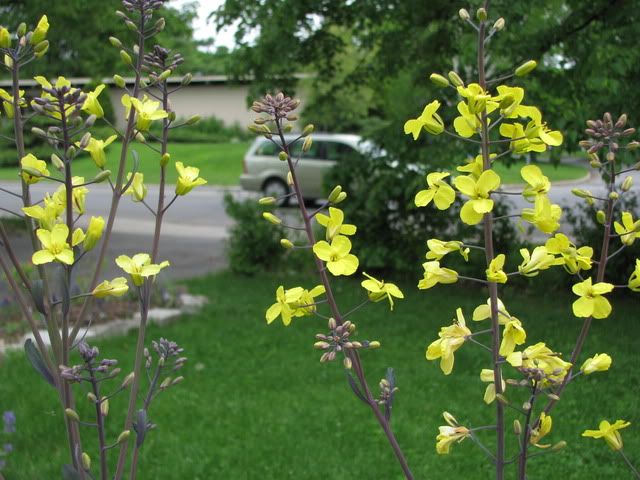
Red Rock Mammoth Cabbage Flowers
Perennials will flower when they are ready. That might be the first year, that might be the second year or that might be hardly ever in the case of walking kale which is traditionally propogated by cuttings.
Population Size
Respect your genetic diversity. These plants are generally outbreeders and self incompatible. You will need more than one. Make sure that you save seed from as many of the best performing individuals as possible. Think at least 20 but twice as much (or more) would be better. If you don't have a lot of space, consider these cheats.
Plant closer together. If you read seed saving books, they will often tell you to replant your mother/father plants farther apart to allow for best growth and seed production. However, if you have to choose between more seeds from a few individuals or less seeds from many individuals, I'd choose the latter.
Grow your parent plants in the middle or back of your ornamental beds. The tall yellow flowering seed heads can be pretty as fillers. Allowing kale and mustards to self seed in drifts will allow you to have a self sustaining population of delicious greens, not take up as much room in your garden and give you the opportunity to collect seeds for trading and giving away to others.
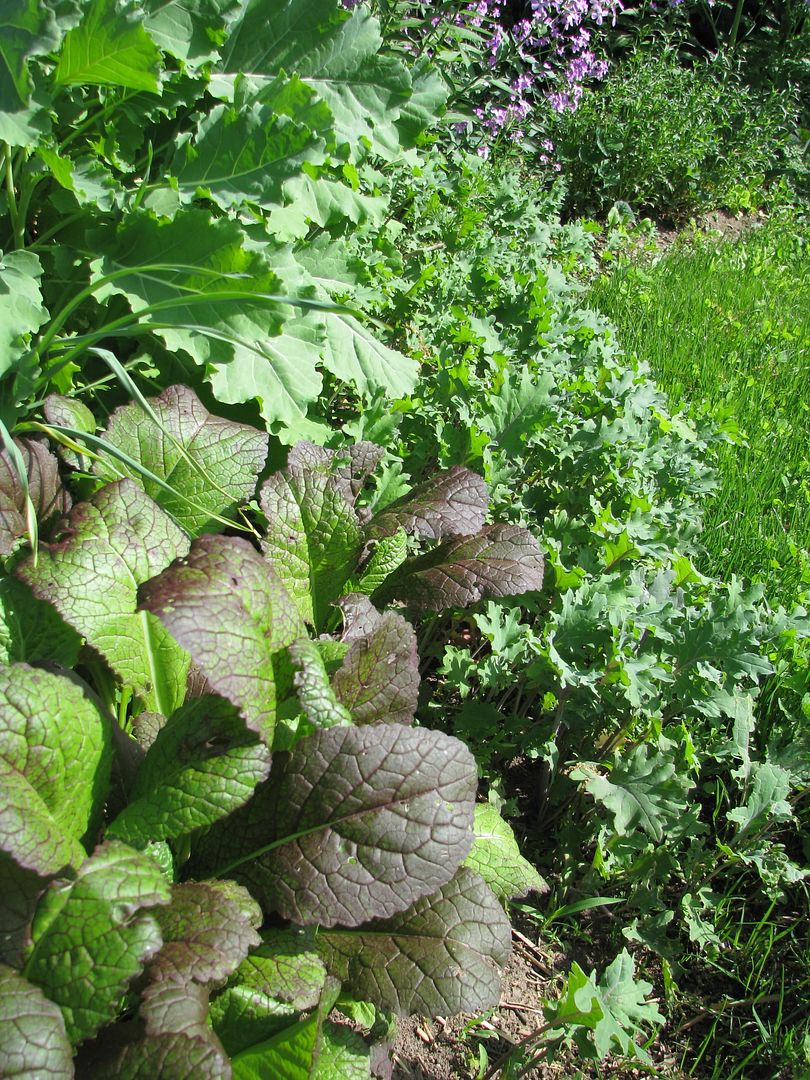
Here you will see volunteer mustard and kale in the front and middle of the border. I will harvest the mustard in the front, replacing it with fall crop. The ones further back will be left as seed parents.
Mix varieties together. To avoid this, you will want to allow only one member of the same Genus species to flower at the same time. If, on the other hand, you want to increase the genetic diversity of your seed crop, consider doing a little backyard hybridization. Let a variety of broccolis flower together. For more on breeding your own veggies, see Carol Deppe's great book on the subject.
Chart of common Brassicas by species*:
Brassica oleracea: cabbage, cauliflower, kholrabi, broccoli, kailaan, brussel sprouts, and some kale
Brassica juncea: some mustards
Brassica rapa: turnip, chinese cabbage, some mustards, some rapini
Brassica napus: rutabaga, some kales
* Same Genus species can cross
Lastly, you can save from fewer individuals and get satsifactory results. Brassica seeds are produced in abundance and are long lived. My advice would be to do it only for one generation and let anyone who you are sharing seed with know that these babies come from a small gene pool.
Seed Collection
Ah the easiest bit. Once most of the seed pods on the stem turn dry and tannish - purple ones will appear rose beige, green ones just beige - snip it off into a large bag or bowl. You can let them dry further inside (in a bag or bowl!) but they will not continue to mature. Some plants are more prone to having shattering pods so you may have to snip them off in stages to prevent losing the seeds.
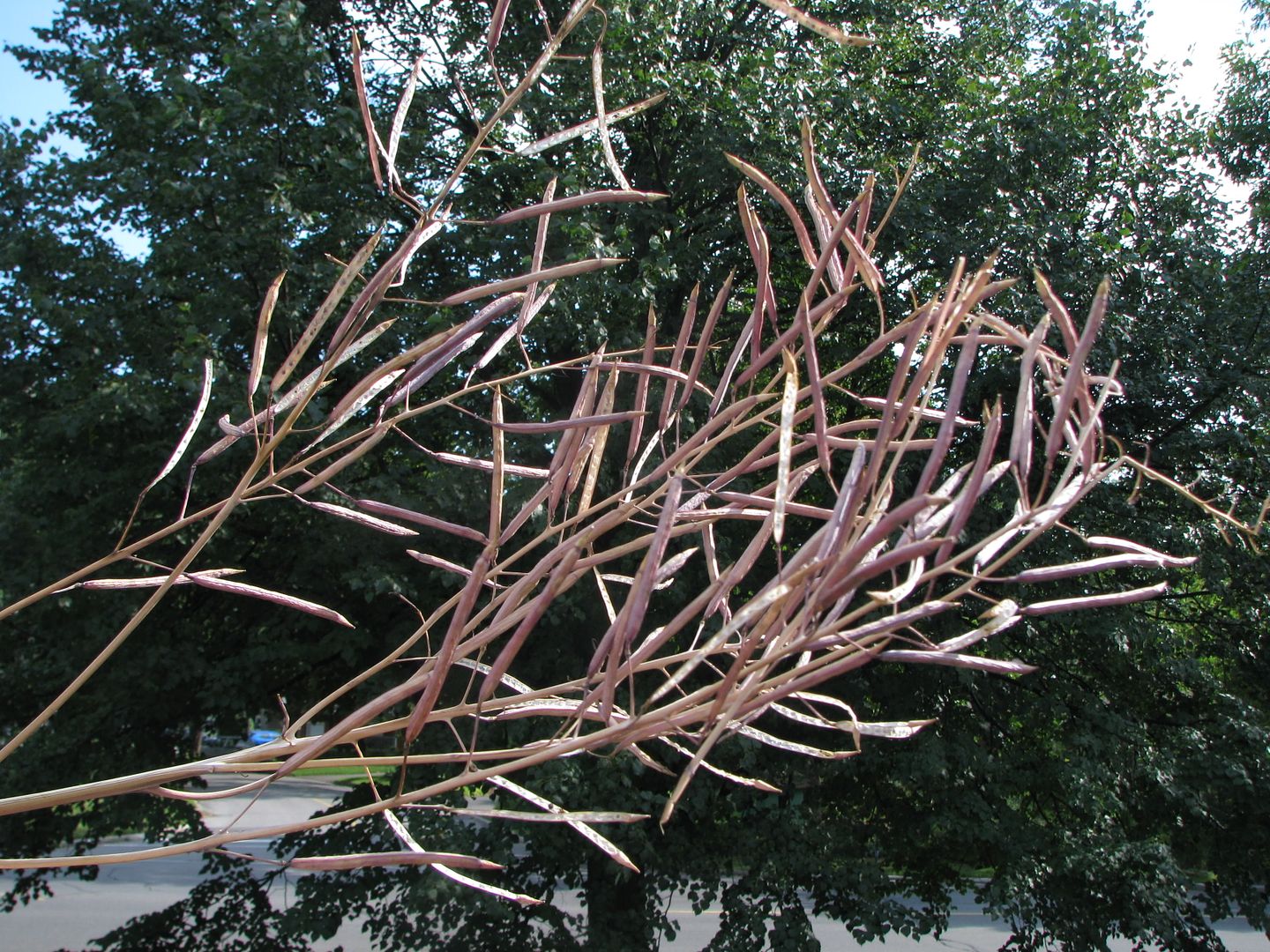
Stem full of pods. Note the rose tan colour.
For delicate pods: These are the easiest. My mustard pods can be easily stripped from the stem by hand. Then just grab handfuls and crush. The seed will pop from the pod. Most of the chaff will be on the surface as the heavier seed sinks so it can be lifted off the top. Any remaining can be winnowed using various methods such as slowly pouring the bowl into another on a breezy (not too blustery day) or even just by blowing.
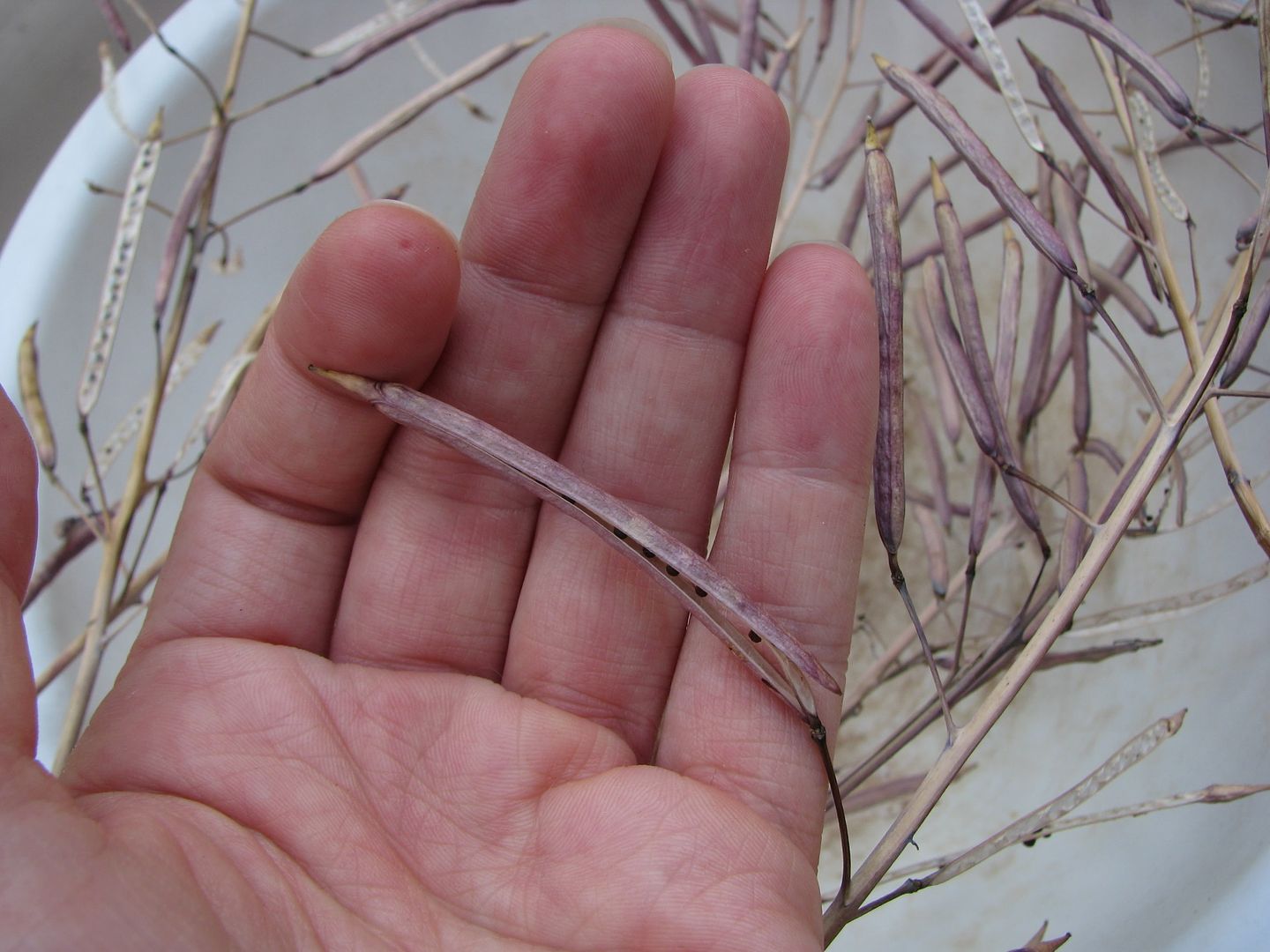
Close up of the Red Rock Mammoth seed pod.
For sturdier pods: My cabbage pods are more hefty so I crush the stems with pods still on in my hands or use the fire starting method pictured below. Just be careful that the seeds are not flung every which way. Most of the chaff can then be lifted off the seeds that will be resting on the bottom of the bowl or bag.
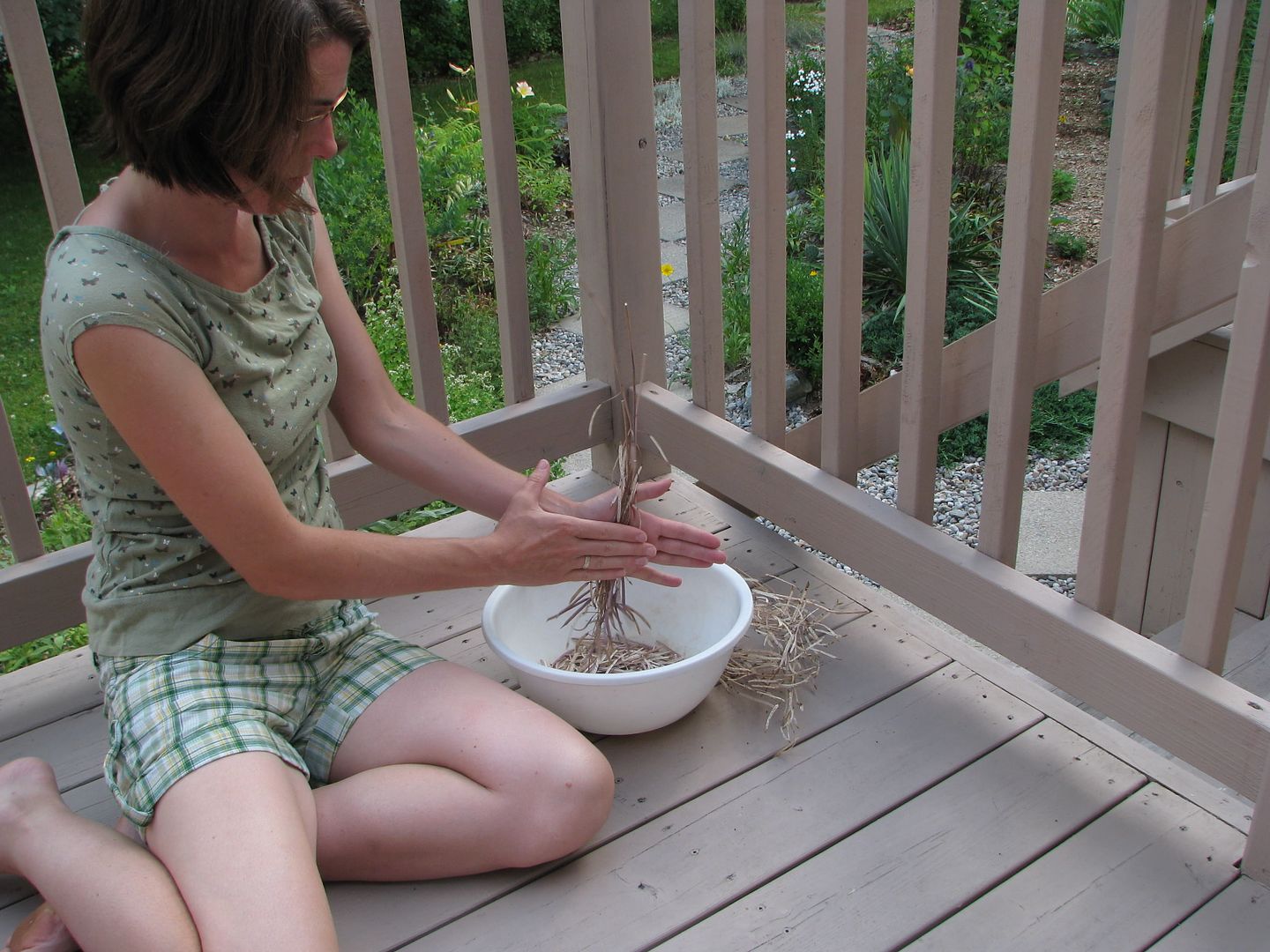
Me, starting a brassica fire - rubbing the stem with pods together in my hands.
Place dry seeds in an air tight container like a jar or a plastic bag, well labelled! (I'm yelling at myself there not you. I have lots of seeds with names like carrot, orange or just __ I guess I expect myself to recognize the seeds...)
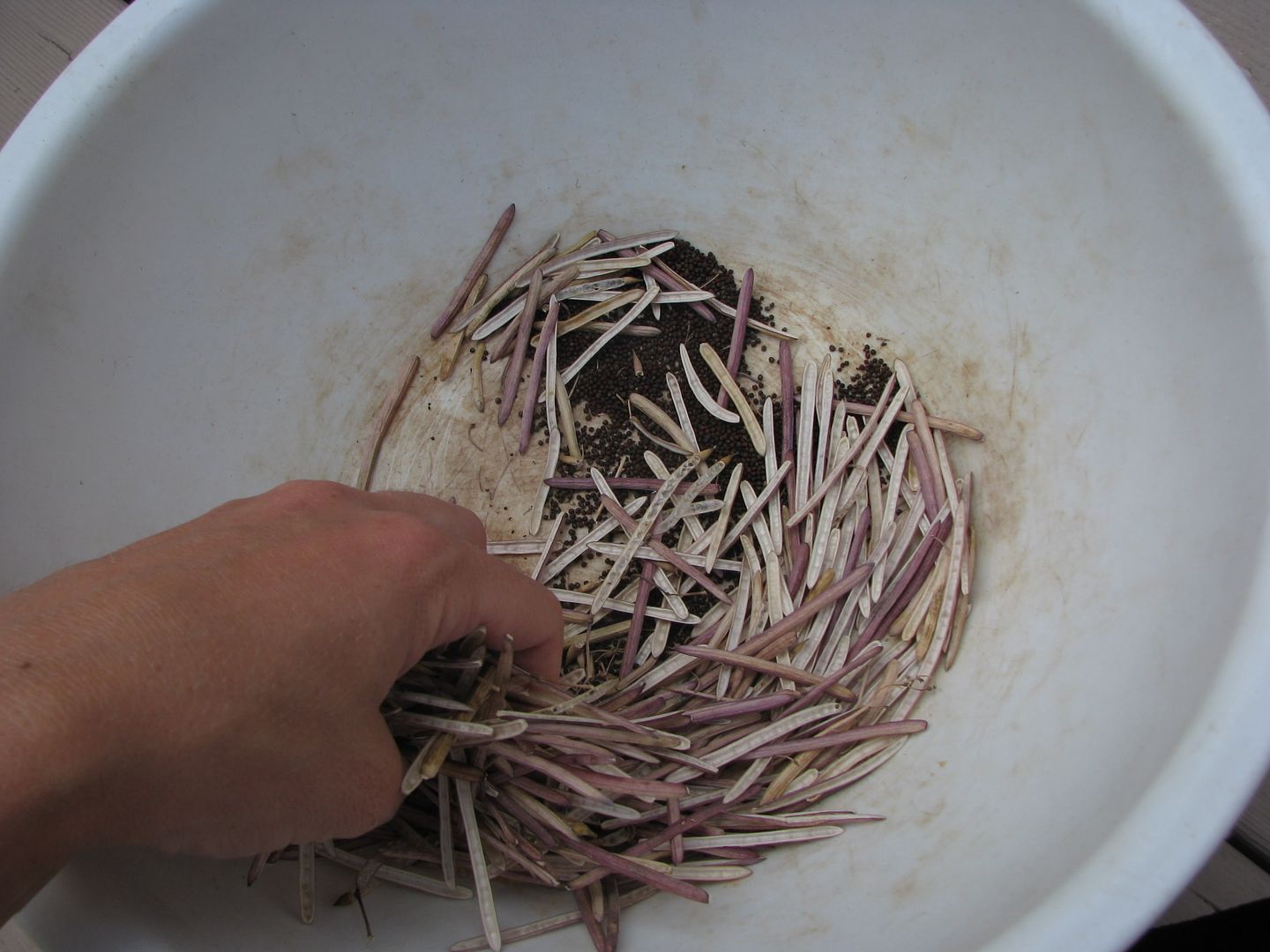
Chaff on top, seeds on bottom.
Previous post on Saving Small Bunches of Brassica Seeds
***
More winnowing techniques from Salt Spring Seeds
Brassica saving notes from Real Seeds
Brassica names
Scroll down for a post by Frank from Homegrown Goodness on saving brassicas

4 comments:
I expect myself to remember way too many times and it just doesn't happen. I should know better by now.
Ah, I was just trying to convince Eldest Child to help me figure out how to get the earwigs out of the large garbage bag of saved kale seeds. Any ideas?
On the plus side, they're easy to sprout in the garden!
That's a lot of kale seeds. I suppose if you sealed the bag, they would only last so long... but I am not sure of the fate of your kale seeds. Alternatively, I you could spread the seed heads out on a tarp and let the earwigs scurry away to a dark place conviniently located nearby??
My kids were playing with a toy barn until I opened the doors to discover it was earwig palace. They don't play with it anymore.
I would try sprinkling baking soda in the bag. That would kill the earwigs but you really want them out of the bag. I agree with Ottowa Gardener. Spread the seeds out in the sun and watch them run away. I had a lot of them in my mailbox and sprinkled a layer of baking soda and no more earwigs. They walk in the baking soda, clean themselves, and blow up because they can't burb. Safe for kids, cats, and dogs.
Post a Comment